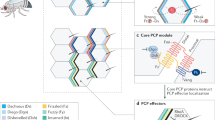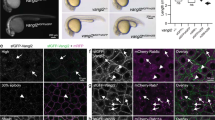Abstract
Tissue organization in Drosophila is regulated by the core planar cell polarity (PCP) proteins Frizzled, Dishevelled, Prickle, Van Gogh and Flamingo. Core PCP proteins are conserved in mammals and function in mammalian tissue organization. Recent studies have identified another group of Drosophila PCP proteins, consisting of the protocadherins Fat and Dachsous (Ds) and the transmembrane protein Four-jointed (Fj). In Drosophila, Fat represses fj transcription, and Ds represses Fat activity in PCP. Here we show that Fat4 is an essential gene that has a key role in vertebrate PCP. Loss of Fat4 disrupts oriented cell divisions and tubule elongation during kidney development, leading to cystic kidney disease. Fat4 genetically interacts with the PCP genes Vangl2 and Fjx1 in cyst formation. In addition, Fat4 represses Fjx1 expression, indicating that Fat signaling is conserved. Together, these data suggest that Fat4 regulates vertebrate PCP and that loss of PCP signaling may underlie some cystic diseases in humans.
This is a preview of subscription content, access via your institution
Access options
Subscribe to this journal
Receive 12 print issues and online access
$209.00 per year
only $17.42 per issue
Buy this article
- Purchase on Springer Link
- Instant access to full article PDF
Prices may be subject to local taxes which are calculated during checkout





Similar content being viewed by others
References
Seifert, J.R. & Mlodzik, M. Frizzled/PCP signalling: a conserved mechanism regulating cell polarity and directed motility. Nat. Rev. Genet. 8, 126–138 (2007).
Saburi, S. & McNeill, H. Organising cells into tissues: new roles for cell adhesion molecules in planar cell polarity. Curr. Opin. Cell Biol. 17, 482–488 (2005).
Montcouquiol, M. et al. Identification of Vangl2 and Scrb1 as planar polarity genes in mammals. Nature 423, 173–177 (2003).
Curtin, J.A. et al. Mutation of Celsr1 disrupts planar polarity of inner ear hair cells and causes severe neural tube defects in the mouse. Curr. Biol. 13, 1129–1133 (2003).
Park, T.J., Haigo, S.L. & Wallingford, J.B. Ciliogenesis defects in embryos lacking inturned or fuzzy function are associated with failure of planar cell polarity and Hedgehog signaling. Nat. Genet. 38, 303–311 (2006).
Zeidler, M.P., Perrimon, N. & Strutt, D.I. The four-jointed gene is required in the Drosophila eye for ommatidial polarity specification. Curr. Biol. 9, 1363–1372 (1999).
Casal, J., Struhl, G. & Lawrence, P.A. Developmental compartments and planar polarity in Drosophila. Curr. Biol. 12, 1189–1198 (2002).
Rawls, A.S., Guinto, J.B. & Wolff, T. The cadherins fat and dachsous regulate dorsal/ventral signaling in the Drosophila eye. Curr. Biol. 12, 1021–1026 (2002).
Yang, C.H., Axelrod, J.D. & Simon, M.A. Regulation of Frizzled by fat-like cadherins during planar polarity signaling in the Drosophila compound eye. Cell 108, 675–688 (2002).
Fanto, M. et al. The tumor-suppressor and cell adhesion molecule Fat controls planar polarity via physical interactions with Atrophin, a transcriptional co-repressor. Development 130, 763–774 (2003).
Simon, M.A. Planar cell polarity in the Drosophila eye is directed by graded Four-jointed and Dachsous expression. Development 131, 6175–6184 (2004).
Matakatsu, H. & Blair, S.S. Separating the adhesive and signaling functions of the Fat and Dachsous protocadherins. Development 133, 2315–2324 (2006).
Matakatsu, H. & Blair, S.S. Interactions between Fat and Dachsous and the regulation of planar cell polarity in the Drosophila wing. Development 131, 3785–3794 (2004).
Ma, D., Yang, C.H., McNeill, H., Simon, M.A. & Axelrod, J.D. Fidelity in planar cell polarity signalling. Nature 421, 543–547 (2003).
Casal, J., Lawrence, P.A. & Struhl, G. Two separate molecular systems, Dachsous/Fat and Starry night/Frizzled, act independently to confer planar cell polarity. Development 133, 4561–4572 (2006).
Rock, R., Schrauth, S. & Gessler, M. Expression of mouse dchs1, fjx1, and fat-j suggests conservation of the planar cell polarity pathway identified in Drosophila. Dev. Dyn. 234, 747–755 (2005).
Jones, C. & Chen, P. Planar cell polarity signaling in vertebrates. Bioessays 29, 120–132 (2007).
Wang, Y., Guo, N. & Nathans, J. The role of Frizzled3 and Frizzled6 in neural tube closure and in the planar polarity of inner-ear sensory hair cells. J. Neurosci. 26, 2147–2156 (2006).
Gong, Y., Mo, C. & Fraser, S.E. Planar cell polarity signalling controls cell division orientation during zebrafish gastrulation. Nature 430, 689–693 (2004).
Baena-Lopez, L.A., Baonza, A. & Garcia-Bellido, A. The orientation of cell divisions determines the shape of Drosophila organs. Curr. Biol. 15, 1640–1644 (2005).
Fischer, E. et al. Defective planar cell polarity in polycystic kidney disease. Nat. Genet. 38, 21–23 (2006).
Probst, B., Rock, R., Gessler, M., Vortkamp, A. & Puschel, A.W. The rodent Four-jointed ortholog Fjx1 regulates dendrite extension. Dev. Biol. 312, 461–470 (2007).
Kume, T., Deng, K. & Hogan, B.L. Murine forkhead/winged helix genes Foxc1 (Mf1) and Foxc2 (Mfh1) are required for the early organogenesis of the kidney and urinary tract. Development 127, 1387–1395 (2000).
Ciani, L., Patel, A., Allen, N.D. & ffrench-Constant, C. Mice lacking the giant protocadherin mFAT1 exhibit renal slit junction abnormalities and a partially penetrant cyclopia and anophthalmia phenotype. Mol. Cell. Biol. 23, 3575–3582 (2003).
Nauli, S.M. et al. Polycystins 1 and 2 mediate mechanosensation in the primary cilium of kidney cells. Nat. Genet. 33, 129–137 (2003).
Yoder, B.K. Role of primary cilia in the pathogenesis of polycystic kidney disease. J. Am. Soc. Nephrol. 18, 1381–1388 (2007).
Hildebrandt, F. & Otto, E. Cilia and centrosomes: a unifying pathogenic concept for cystic kidney disease? Nat. Rev. Genet. 6, 928–940 (2005).
Patel, V. et al. Acute kidney injury and aberrant planar cell polarity induce cyst formation in mice lacking renal cilia. Hum. Mol. Genet. 17, 1578–1590 (2008).
Torres, V.E. & Harris, P.C. Mechanisms of disease: autosomal dominant and recessive polycystic kidney diseases. Nat. Clin. Pract. Nephrol. 2, 40–55 (2006).
Simons, M. & Walz, G. Polycystic kidney disease: cell division without a c(l)ue? Kidney Int. 70, 854–864 (2006).
Acknowledgements
We are grateful to I. Rosewell of Cancer Research UK for help in generating the Fat4 germline chimeras. We also thank J. Hoyer (University of Delaware), M. Knepper (National Heart, Lung, and Blood Institute), T. Carroll (University of Texas Southwestern), B. Bruneau (University of California, San Francisco) and the Developmental Studies Hybridoma bank for antibodies and probes, J. Johnson (University of Texas Southwestern) for the Math-1-GFP mice, P. Gros (McGill University) for mice and antibodies and A. Vortkamp (Universitaet Duisburg-Essen) for help with generating the Fjx1-null mice. This work was supported by grants from the Canadian Institute for Health Research (MOP84468) and Cancer Research UK to H.M. and from the Fondation pour la Recherche Medical and PKD foundation to M.P. We apologize to those whose work we were unable to cite because of space constraints.
Author information
Authors and Affiliations
Contributions
S.S. and H.M. designed the experiments, analyzed the data and wrote the paper. M.G. provided mice. R.M. and R.H. analyzed the inner ear phenotype. S.S., V.E. and I.H. conducted the in situ hybridizations. E.F. and M.P. analyzed spindle orientation. S.S. analyzed the cochlea elongation phenotype, neural tube phenotype and cystic kidney morphometric analysis. S.E.Q. helped in the analysis of cystic kidney phenotypes. S.S. and I.H. conducted the immunohistochemistry.
Corresponding author
Supplementary information
Supplementary Text and Figures
Supplementary Figures 1–6, Supplementary Tables 1 and 2, Supplementary Methods (PDF 2291 kb)
Rights and permissions
About this article
Cite this article
Saburi, S., Hester, I., Fischer, E. et al. Loss of Fat4 disrupts PCP signaling and oriented cell division and leads to cystic kidney disease. Nat Genet 40, 1010–1015 (2008). https://doi.org/10.1038/ng.179
Received:
Accepted:
Published:
Issue Date:
DOI: https://doi.org/10.1038/ng.179
This article is cited by
-
FAT4 overexpression promotes antitumor immunity by regulating the β-catenin/STT3/PD-L1 axis in cervical cancer
Journal of Experimental & Clinical Cancer Research (2023)
-
Mechanism of cystogenesis by Cd79a-driven, conditional mTOR activation in developing mouse nephrons
Scientific Reports (2023)
-
Fat3 regulates neural progenitor cells by promoting Yap activity during spinal cord development
Scientific Reports (2022)
-
Planar cell polarity pathway in kidney development, function and disease
Nature Reviews Nephrology (2021)
-
mTOR and S6K1 drive polycystic kidney by the control of Afadin-dependent oriented cell division
Nature Communications (2020)



